TWENTY-TWENTY FORESIGHT
North Vegetable Garden
I’m stepping outside this sunny afternoon for a walk around the farmden, pad and pen in hand to evaluate some of this season’s goings on to make notes for next season. Not that the season is anywhere near over yet. I expect to be out and about with pitchfork, harvest basket, and garden cart at least into December. But no surprises are expected at this point.
Starting in the north vegetable garden: tomatoes. Over the years I’ve honed the number of varieties here from too many to our half-dozen or so favorites.
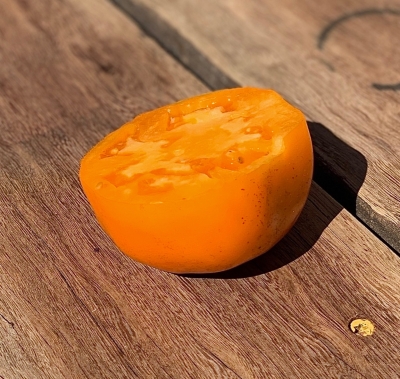
Valencia tomato
The goal is top-notch flavor and reasonable productivity. San Marzano, which is very productive, might taste like cotton fresh but it’s a must for the best-tasting cooked tomatoes. The San Marzanos get their dedicated canning jars, but also good canned is Blue Beech and, great for fresh eating also, are Amish Paste and Anna Russian.
Three more, mostly for fresh eating next year, are Paul Robeson, Belgian Giant, and Valencia. Valencia has year after year proven to be a very good, very beautiful, and productive tomato. Pretty also, round, smooth, and pale orange. Cherokee Purple hardly produced this year, and hasn’t in years past, so it’s scrapped from the list for next year.
I consider Sungold to be the best-tasting cherry tomato, and it’s still bearing a daily abundance of persimmon-orange fruits. I put in 8 plants; next year, I’ll plant a few more.
That makes a total of only seven tomato varieties — unless someone twists my arm into trying any other variety.
I’ll try for a repeat abundance of peppers next year by again growing Carmen and Sweet Italia.
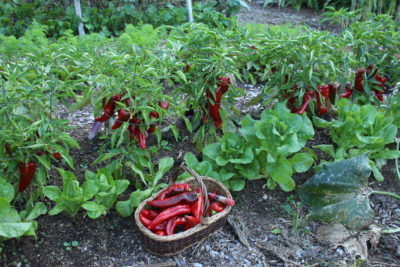
Sweet Italia peppers
Sweet Italia tastes better but Carmen bears a little better, especially now. The non-hot hot pepper Habenada, is billed as having hot pepper flavor minus the hotness. More like no hotness and no flavor, a no-go for next year.
South Vegetable Garden
Walking over to the “south garden,” the highlights this year were cauliflower, beans, and squash. Cauliflower is allegedly a challenge to grow. I don’t like it so grew it just for the challenge, and because Deb likes it. I was successful, and she can eat it all.
Blue Lake and Kentucky Wonder pole beans keep pumping tender new beans, as pole beans are wont to do. Or is it Blue Lake and Romano? Or Kentucky Wonder and Romano? The row label is buried deep in a wall of foliage so I won’t know until the end of the season. 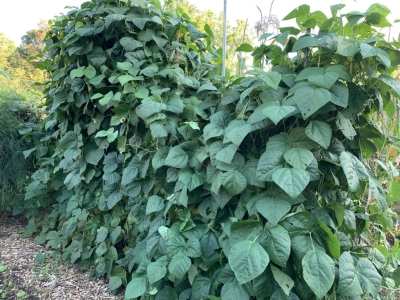 I guess two plants per pole, with poles about a foot apart, is too crowded. Next year: one plant per pole.
I guess two plants per pole, with poles about a foot apart, is too crowded. Next year: one plant per pole.
Pole beans begin bearing late so I also grow bush beans (bush Blue Lake and bush Romano), which peter out after a couple of weeks but yield an early crop for the freezer. I usually put in a second planting also, which is — note for next year — not needed. We didn’t have to harvest any of them because the pole beans kicked in soon enough.
It’s been a banner year for winter squash. I usually plant squash out in the meadow in the cleared strip of land between the dwarf apple trees. And usually, deer or my poultry eat the vines or the fruit so the harvest is usually nil. This year I planted squash in the rich soil along and inside the back fence of the south garden, which backs up to the poultry run. The squash climbed up and over the fence and onto the fenced roof of the run; now there’s plenty to harvest, perhaps too many!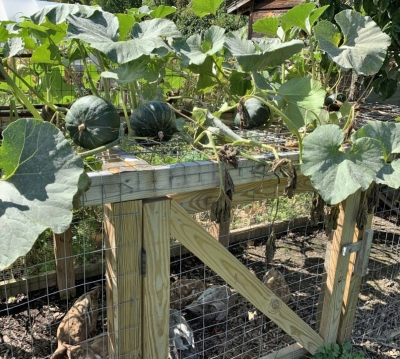
South Vegetable Garden
Two flowers were standouts this year: On a whim I purchased red buckwheat seed from Baker’s Creek (www.rareseeds.com). With no place special in mind about where to plant it, I ended up sprinkling the seed in a bed just outside the north vegetable garden.

For the past couple of months it’s been a 4-foot high cloud of pale red beauty, which, along with how easy it is to grow, earns it a place in next year’s garden. But where?
One other flower stood out also, delphinium. Not a five foot spire of pale blue — I also have them, the Pacific Giant hybrids — but a spire less than two feet tall with dark blue flowers.
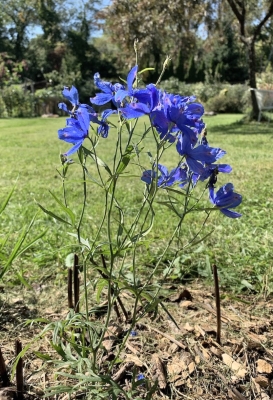
It’s Blue Mirror Chinese delphinium (www.reneesgarden.com) and it surprised me by blooming its first year from seed. Let’s see how perennial this perennial turns out to be. Around here, its giant cousins typically die out after a couple of years.
All in all, it’s been an excellent growing season. Spring frost hazard was minor for tree fruits. Rainfall and sunshine were balanced well. Pest problems were minor. Pears are still challenging to harvest at just the right moment so that they can ripen indoors to that delectable window between underripe grassy and overripe sleepy. I did get Concorde at the right moment this year. The ripe fruits are delectable, combining some of the smooth buttery sweetness of Magness pear along with a dash of vanilla.


Lee,
Where do you get your tomatoes? Are you planting their seeds only?
I am using only seedlings from Bonnie, which I find inconsistent in their performance. I don’t have means to grow seedlings myself.
Thank you.
I buy seed and grow my own seedlings. Around here, a number of small vegetable farms have seedling sales and they usually have some really good tasting tomato plants. Check out small farms.
Lee:
It was a nice year for some plants. Tomatoes ans Peppers did well. I planted some Leek and Carrots on my deck in 10″ pots. results not in yet.
Pole beans did well. Bush beans have a difficult time getting going because of bunnies getting into the garden.
Squash which I love. I will be heading up to New Hampshire in a few weeks where I can buy squash less expensive than I can produce it in my garden.
Well. Out to my garden with a note pad also for next season
Thank again for your informational notes.
Ken
Thanks, for all of your great advice, Lee! I’ll try a couple more of your favorites next year. To Sungold among the small tomatoes, I would add Mexico Midget–even smaller and oh, so sweet! And to Amish Paste, my favorite slicer, Black Krim. This year I have just two of the Midget plants and have picked just over 400 of the little red treats.
EIGHT sungold plants?!
How do you have time to pick them all?
Good question.
Ditto the Cherokee Purple performance in what I believe is a similar climate of Burlington, WI. I also grew Pink Boar which I’ve been delighted with with its tasty dark flesh, although smaller than CP. I’d call it a salad tomato vs a sandwich one. I expected bigger with a name like boar, but I’m ok with that. They haven’t cracked a bit for me with some heavy rains inducing splits in others at times this summer. Black Prince – nope, a cracker/splitter. So Pink Boar will get another go next year in my dark fleshed (inside, not out) roster spot.
Sorry to hear your Cherokee Purples didn’t turn out well Lee. The last several years I have gotten my Cherokee Purples as plants from Hudson Valley Seeds. I put in 15 plants and harvest close to 200 pounds each year. This year was a great year for tomatoes in our region (Hudson Valley). I find this tomato to not only be the best tasting fresh, but makes stupendous sauce that I freeze about 30 quarts of each year. If that was not enough to recommend it, this tomato is my earliest ripener and longest fruiting. I also grow and like the Sungold Cherries.